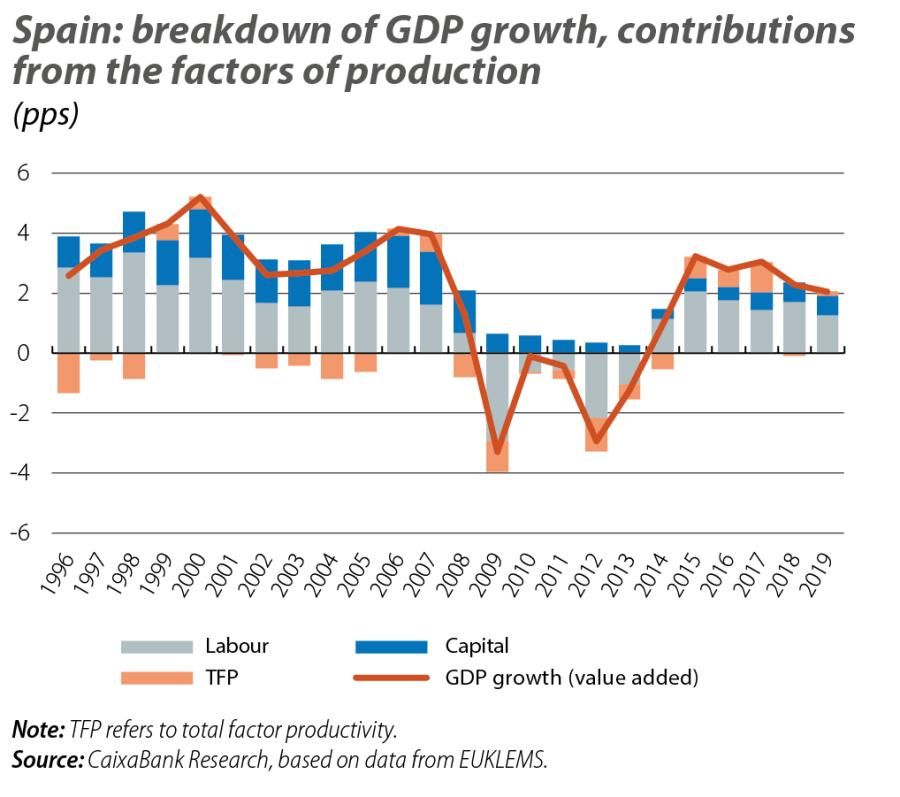Productivity in Spain: a lot of scope for improvement
What exactly is productivity and how can we measure it? Where does Spain lie in terms of its productivity compared to the rest of the euro area? With this article, we launch a series on the fundamentals of the Spanish economy, which will continue in the monthly reports of the coming months.

What is productivity and how to measure it
Productivity is often defined as a «magic ingredient», the main source of economic prosperity in the medium term. However, productivity is not an ingredient, but a result, and its nature and fundamentals are topics that are rarely discussed. Let us look at what productivity really is, how it can be measured and where Spain lies in the international context. This Focus opens a collection of articles of a structural nature on the fundamentals of the Spanish economy, which will continue in the monthly reports of the coming months.
Simply put, productivity is the level of output generated with a certain level of inputs. An optimal combination or management of resources (inputs) results in more efficiency, leads to greater productivity and ultimately allows for the creation of greater wealth.
Labour is one of the most important factors of production and the ratio of the amount of the labour factor that is used to generate a unit of GDP is the most widely used means of measuring productivity. The indicator developed by Eurostat, which divides an economy’s GDP by the number of hours worked (the so-called apparent labour productivity), expresses the value that is created per unit of work used (hour of work), and it is more precise than other measures which compare output with the number of workers.
The problem with this measure is that it can be contaminated by various elements. For instance, if an economy gives more capital to its workers, they will produce more and the apparent labour productivity will rise. But this increase in productivity will be due to the accumulation of capital, rather than these workers being more productive with the same amount of capital and with other conditions being equal. To avoid this confusion, the concept of total factor productivity (TFP) appears. This variable captures the increase in production that is not due to an increase in the accumulation of other factors of production, such as capital, labour, etc. It is a cleaner measure of productivity, but one that is more difficult to measure, since it is not directly observable.

Productivity in Spain and the euro area
In recent years, the growth of the Spanish economy has been determined by a high contribution from the labour factor, given the abundance of labour that has traditionally characterised our economy, while the contribution from productivity has been more moderate. Specifically, the average growth of the Spanish economy in 2014-2019 was 2.4% in real terms, which is broken down into labour factor growth of 1.6%, 0.5% growth for the capital factor and just 0.3% in the case of TFP (see first chart).
If we focus on Spain’s apparent labour productivity, a metric for which more recent data is available than for TFP, its average growth between 2014 and 2022 in real terms was 0.3%, below the 0.9% for the EU as a whole. Delving into an international comparison, we see (second chart) that there is a significant gap between Spain’s productivity level and that of the euro area and the main European economies. In 2022, nominal GDP per hour worked in Spain (already taking into account the September 2023 revision of Spain’s historical GDP series) was 76% of the value recorded in the euro area, and just 63% of that of Germany. More worrisome than the gap itself is the fact that this gap has barely narrowed in the last two decades (in 2000, GDP per hour worked in Spain was 74% of the value recorded in the euro area and 61% of that of Germany).

What explains these differences? One of the keys to productivity lies in the quality of an economy’s human capital. Workers with a higher educational level and who are technically more qualified are more productive. According to a study by the Bank of Spain (see third chart), there is a significant deficit in the level of education and training of Spanish workers and entrepreneurs compared to the euro area average.1
- 1See Á. Gavilán (2022). «El crecimiento de la productividad en la economía española: ¿síntoma o problema?». CEPYME conferences: El problema de la productividad en la empresa español.

Productivity and company size
On the other hand, another key aspect for productivity is the size of an economy’s companies. In Spain, the productivity level of large corporations is more than double that of micro-enterprises. However, the relative weight of medium- or large-sized companies in the Spanish economy is lower than in other countries. In Spain, around 35% of employment is in companies with over 50 employees, whereas this proportion stands at 66% in Germany. Spain needs to further boost the growth of its micro-enterprises and SMEs.

Several studies point out that large corporations have a greater propensity to invest in intangible assets and highlight this type of investment as a catalyst for increased productivity.2 Intangibles which help to boost productivity include, for instance, management and organisational efficiency models, marketing, brand value, databases, specific training developed in-house and software. In highly developed economies that are close to the technological cutting edge, these aspects are even more determinant in productivity growth. Thus, when we talk about the future of productivity in Spain, it is essential to analyse the relative weight of investment in research and development in the economy. Specifically, the portion of GDP that is allocated to research and development (see fifth chart) in Spain is 1.3%, well
below the 2.0% euro area average.
- 2See C. Corrado, J. Haskel, C. Jona-Lasinio et al. (2018). «Intangible investment in the EU and US before and since the Great Recession and its contribution to productiv ity growth». Journal of Infrastructure Policy and Development.

In short, achieving a substantial improvement in productivity in the Spanish economy will require us to focus, among other determining factors, on education, business size and innovation.
